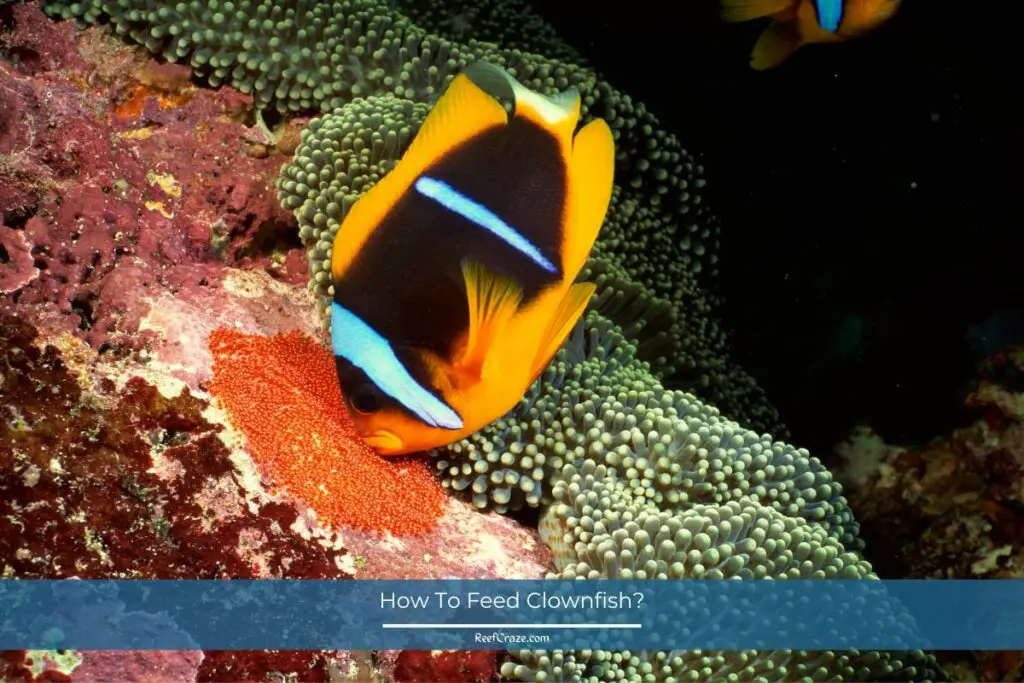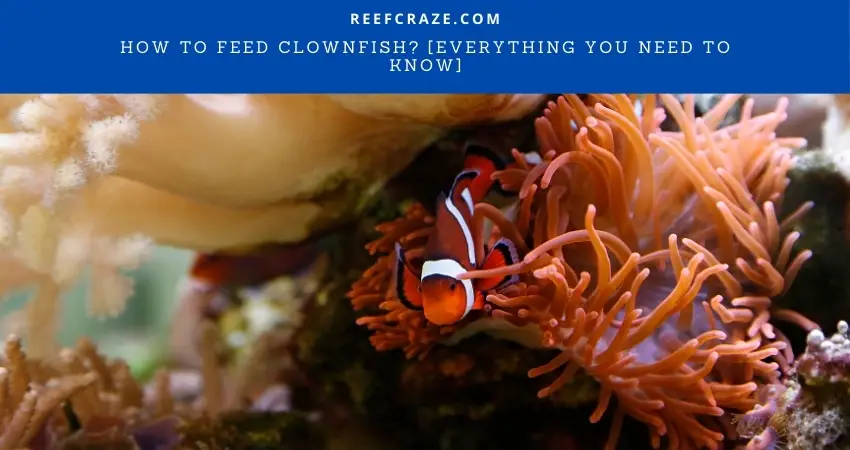Clownfish are heavy eaters. Don’t you believe me? Wait till you have one. And if you already have one or more clownfish, it is essential to know how to feed clownfish. Otherwise, you can end up starving or overfeeding them.
You need to provide clownfish with enough food that they can finish in a minute or two. If it is a juvenile clownfish, it needs food three to four times a day. You can feed a grown clownfish once or twice a day.
Feeding a clownfish comes with a few more things to consider. Since you are already here, why not read a little further and learn more about feeding clownfish?

What Do Clownfish Eat?
Clownfish are not picky when it comes to food. They have an appetite for both plants and animal matter. So they will eat anything they find, anywhere they see it.
In the wild, clownfish eat fish eggs, algae, larvae, zooplankton, seaweeds, etc. They even eat the tentacles of the anemones they host in. Wild clownfish grow this food habit as they do not have access to eat like aquarium fishes.
Yet, you will get the same scenario from your aquarium clownfish. Even though they probably were not in the sea, tank clownfish act like those in the wild.
The only difference with aquarium clownfish is that you can give them various food. Many of these foods contain essential nutrients that help the clownfish be healthy and grow well.
Read Also: Do Clownfish Eat Their Babies?
How To Feed Clownfish?
Your clownfish need feeding based on their age or growth. Young or juvenile clownfish need to eat more frequently than the grown ones.
Leave enough food in the tank during the feeding time that the fish can eat in a minute or two. If you have more than one clownfish, make sure they all have eaten the food.
Clownfish live on different diets. Not all of them require the same type and amount of food. Moreover, you need to maintain a specific time to feed them every day. I will discuss more on these topics in the following part of this article.

What To Feed Clownfish?
Clownfish love it when you change their food every once in a while. It’s like watching a toddler getting a new toy. They just keep swimming around the food excitedly and eat.
So, what do you feed your aquarium clownfish? Here are different types of food that will boost your clownfish’s health.
Pallet Food/Flakes
You will easily find these foods in any fish store. Pallet foods usually contain squid, seaweed, krill, spirulina, and more. Aquarium clownfish enjoy pallet foods, and they are simpler to handle.
Flake foods are similar to pallet foods and are also high in nutrition. That’s why such food is as popular as the pallet ones. I suggest you provide your clownfish a mix of pallet and flake foods.
Dry Food
Dry foods contain rich nutrition for your clownfish and come in various forms. They also keep the essential vitamins from oxidizing.
You will find different types of dried foods for your clownfish. Remember that the more variety you add, the better it is for your fish. You can add them to your clownfish’s diet as essential supplements.
Frozen Food
There are endless frozen foods for clownfish in the market. And almost all of them are high in nutrition. The perk of providing the clownfish with frozen food is that these are pretty close to giving them fresh food.
Brine shrimps and Mysis shrimps are excellent as clownfish’s diet, and you will find them in the frozen food category. Many frozen clownfish foods provide adequate nutrition for the fish to grow healthy.
You can also give them frozen spirulina. However, it is best to mix several types and feed the fish. Nevertheless, thaw the frozen food before you give it to your fish.
Freeze-Dried Food
Freeze-dried foods are more like supplements for your clownfish. This type of food is very nutritious for sick clownfish as it can soak vitamins.
The best way to give your fish freeze-dried food is with liquid vitamins. Put the freeze-dried food into a bowl and pour some liquid fish vitamins over the food.
It will take a few minutes for the food to soak with the vitamins thoroughly. Then you can serve it to your sick clownfish.
Live Food
It is challenging to have clownfish without adding some meat to their diets sometimes. And when it comes to living foods, clownfish thrive on them, and it kicks their wild instinct.
Krills, brine shrimps, Mysis shrimp are excellent choices for live and meaty food. These are tiny foods, and clownfish can quickly devour them.
Moreover, they are the type of food you should feed your clownfish when breeding. You can find these foods in local fish markets and fish stores.
Vegetables/Algae Sheets
You should know that clownfish are omnivores. It means they can eat vegetables and plants as well. Vegetables such as spinach and nori or algae sheets are available in grocery stores.
You can give the chard or cooked spinach. The clownfish will not complain. Trust me. The spirulina you will find in pallets goes head to head with the food of this category.
Algae sheets are basically dry seaweeds. You can clip the sheets with suction cups to the aquarium walls for your clownfish to eat from it.
This algae sheet comes in handy if your fish tank is low in algae growth. However, avoid feeding your clownfish with algae sheets if your fish tank has excess algae growth.
How Often To Feed Clownfish?
Clownfish are cleverer than you think. They will stare like those adorable kittens and puppies, and it will make you want to feed them the universe. But do not fall for that look. That’s where everything goes wrong.
Clownfish are vicious eaters and will eat food anytime you give them. But it would be best if you feed them during a fixed time of the day and night.
Though some people, including professionals, will tell you that the clownfish need feeding once a day. But I like to feed my clownfish twice, and I make sure the food amount is balanced.
If you have juvenile clownfish, you can feed them three to four times a day. And whatever you do, try not to overfeed them. Just give them enough food that they can finish in a minute or two.
Problems With Overfeeding Clownfish?
Did you ever notice that clownfish do not stop eating until you stop giving them food? That’s right! These greedy eaters will keep devouring food as long as you give them and will not regret it.
But even if they don’t, it can make you regret your decision to overfeed them. And you are not alone in this. Many clownfish owners make this mistake without knowing that overfeeding clownfish can cause severe health issues.
Other than making the fish sick, the excessive food waste will start to make your aquarium environment toxic. And it will only lead to further health issues for the fish. So let’s say it is safe to stick to a regular feeding schedule and not overfeed the clownfish.
How Long Can Clownfish Go Without Food?
It makes me panicky when people ask this question. But I understand that learning the answer is important. You never know if you have to leave home for a few days and keep the fish unfed during the time. But will the clownfish survive without food?
No fish can survive if they do not get food for a long time. As for clownfish, they can survive without food for up to three days. The bigger clownfish can survive more days without food than the juvenile ones.
Some clownfish can survive for up to a week without food. But the less they stay without food, the better.
Remember that the clownfish need to be fed a few times daily. So you should not starve them intentionally. If the situation is unavoidable, you can leave them without food for a few days or put someone else in charge to feed them.
Tips For Feeding Clownfish
It’s not difficult when it comes to feeding your clownfish. But you still need to consider a few things for the sake of your fish’s health. Here are some tips that you can follow regarding feeding your clownfish:
- Do not feed the fish if it seems uninterested in the food. It’s probably not hungry.
- Provide enough food for the fish to eat in a minute or so. Excessive food will go to waste, and it will only pollute the tank environment.
- Juvenile clownfish may not want to swim around the tank to find food. You may find them in a specific spot most of the time. Place their food at their spots until they get comfortable with the others.
- Always bring variety in the food because clownfish may get tired of eating the same food.
- Avoid placing food where the water flow is too high. You can turn off the pump during feeding time to maintain a calm situation.
- Try adding snails, starfish, or crabs in the tank. They will keep the tank clean by eating excessive foods.
Final Words
Feeding clownfish can become a little confusing at the beginning. But the more time you will observe, the more you will understand how to feed clownfish.
The feeding should be based on the fish’s size and age. Bigger clownfish require less feeding than the younger ones. Do provide them with surprise special treats from time to time to keep them more enthusiastic.
If you notice that you have overfed the clownfish one time, try not to feed it again for several hours. And do not forget to clean the remaining foods after the fish finish eating.
